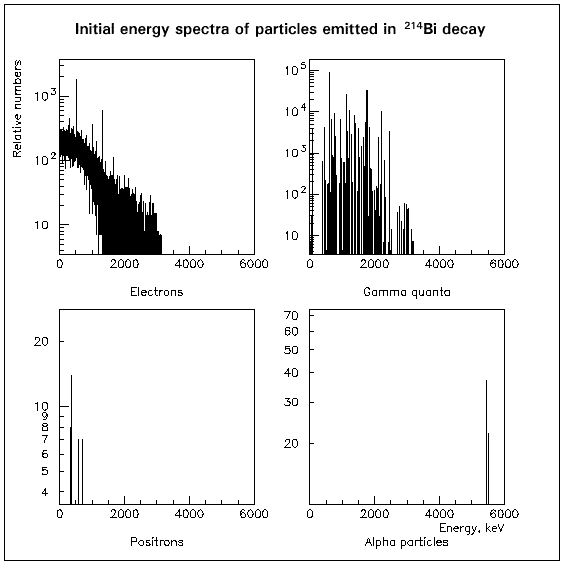 |
| Initial energy spectra of particles emitted in decay of 214Bi |
In any program for simulation of interactions of particles with an experimental set-up, based on such general packages as, for example, GEANT or EGS, user should describe the geometry of measurements and initial kinematics of events. Event generator is an important part of the simulation program giving the information on which particles and how many of them were emitted, what are their energies, directions of movement and times of emission. A code, named DECAY4, was developed [108] (see references in the publications of the LPD group) to generate events of double beta decay and decay of radioactive nuclides.
For double beta processes, DECAY4 describes 2β- (decay with emission of two electrons), 2β+ (decay with emission of two positrons), εβ+ (electron capture with emission of one positron) and 2ε (double electron capture) events for all 69 known nuclei candidates for such processes [44, 125]. Transitions to the ground state as well to excited levels of daughter nucleus are allowed. For each transition, various modes (with emission of two neutrinos or Majoron(s), neutrinoless decays due to non-zero neutrino mass or right-handed admixture in the weak interaction, etc.) and mechanisms (two-nucleon or Δ-isobar) of double beta decay are possible. Energies and directions of particles are sampled in accordance with theoretical energy and angular distributions [44].
For decay of natural radioactive nuclides, the DECAY4 code gives possibility to generate the decay (EC, α, β-, β+) of all known isotopes. The NuDat data base library, including near 3100 isotopes (compilation of Brookhaven National Laboratory, USA) or directly the ENSDF data base files are used for information on the decay modes, energy releases, transition probabilities, parameters of nuclear levels (time of life, spin), radiation energies, coefficients of internal conversion to electrons and e-e+ pairs. The DECAY4 samples the energy, time of decay and direction for the following emitted particles:
1) electrons and positrons from β± decay. The Coulomb distortion factor and correction for forbidden β decays are taken into account in the calculation of energy spectrum;
2) α particles from α decay;
3) γ quanta from nuclear de-excitation process. For cascade of few γ's, the angular correlation between subsequent γ quanta is calculated. Angular correlation is taken into account also for emitted γ quantum and conversion electron;
4) conversion electrons;
5) e-e+ pairs from high energy internal transitions;
6) X-rays (K, L, M) and Auger electrons after the electron capture or nuclear transition with emission of conversion electron.
An example of the DECAY4 output information - energy spectra of emitted electrons, positrons, γ quanta and α particles in decay of 214Bi - is shown in figure.
Applications. The DECAY4 code was successfully used in several underground experiments for detectors design and optimization, simulation of the backgrounds and for evaluation of the results. Some examples are listed below.
1. Kiev 2β decay experiments performed in the Solotvina Underground Laboratory:
1.1. measurements with cadmium tungstate crystal scintillators (enriched in 116Cd to 83%) to investigate 2β decay of 116Cd [43, 103, 140], 2β processes in other Cd and W isotopes [46, 141], and α decays of W nuclei [47, 139];
1.2. search for 2β decays of 160Gd and Ce isotopes with the help of Gd2SiO5:Ce crystal scintillator [62, 115].
2. DAMA collaboration experiments performed deep underground in the Gran Sasso National Laboratory:
2.1. studies of 2β processes in 40Ca and 46Ca with two radiopure CaF2:Eu crystal scintillators [91];
2.2. search for 2β decay of 106Cd with the help of two low-background NaI(Tl) crystals and enriched (to 68%) 106Cd sample [87];
2.3. experiments with liquid Xe scintillator to search for charge non-conserving electron decay [102] and 129Xe nuclear excitations [89];
2.4. search for (di-)nucleon decays into invisible channels with the help of liquid Xe scintillator [104];
2.5. search for 2β processes in 136Ce, 138Ce and α decay of 142Ce [145].
3. NEMO collaboration experiments performed in the Frejus Underground Laboratory to study 2β decay of 82Se [84], 94Zr [92], 96Zr [92], 100Mo [49] and 116Cd [48, 67] with the NEMO-2 set-up (the first version of the DECAY4 code was used).
4. Heidelberg-Kiev collaboration:
4.1. search for 2β decay of 106Cd with the help of CdWO4 scintillator [66];
4.2. background simulations for the GENIUS project: contributions from the cosmogenic activity, produced in Ge detectors, and from their radioactive impurities as well as from contamination of the liquid nitrogen and other materials were calculated. External γ, μ and neutron backgrounds were considered also [99].
5. Calculation of backgrounds from different sources for large-scale proposals in the neutrino physics and 2β decay researches: CAMEO (2β decay of 100Mo and 116Cd) [105, 113], GEM (2β decay of 76Ge and dark matter investigations) [116] and experiment with Gd2SiO5 crystals (2β decay of 160Gd and solar neutrino studies) [115].
6. Simulation of response functions of massive XMASS detector with liquid Xe for solar neutrinos signal, 2β decay of 136Xe and dark matter [137].
 |
| Initial energy spectra of particles emitted in decay of 214Bi |